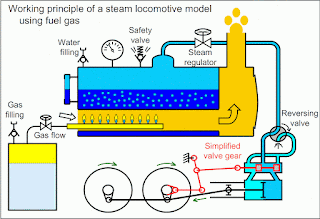Hi there ! Today, in Social Sciences class, we have talked about several things. First of all, about the videos, because there are some people who can't upload their videos to Youtube, and Paqui has told us that there are some ways of reducing the capacity of the videos with Movie Maker or some other programmes. Then we have decided about the date of the exam of this unit, because there are some people who are going to take the exam instead of doing the project.
Later, we have studied the 1st Industrial Revolution. The Industrial Revolution was a big change in the way of producing products, which led to important changes in economy.
Source: http://image.shutterstock.com/z/stock-vector-industrial-revolution-195035411.jpg
It was produced because there was bigger demand for all types of products. The main inventions and innovations of this revolution were;
-The steam engine, which consisted of water, a steam and an engine. The water is boiled and the steam is used to move an engine. It was invented by James Watt
Source:https://upload.wikimedia.org/wikipedia/commons/f/f7/Working_principle_of_steam_locomotive_model.gif:
Source: http://www.biografiasyvidas.com/biografia/w/fotos/watt.jpg
-Use of New Energy Sources, as the Hydraulic power and the mineral coal
-Creation of the Factory System:Concentration of machines and workers in big factories and division of work. Working conditions got worse because people had to work to the rhythm of machines, because if they stopped, production also stopped. And, as people had to work not only from sunrise to sunset, but longer workdays they got really tired. And you had to work in that way, because if not, you got fired . Thus, working condintions were really bad. Men, women and children had to work there.
Source: https://hmcontemporaneo.files.wordpress.com/2011/05/factory_system.jpg
Working in the countryside was not as hard as working in factories, because you could work with your rhythm, and you could stop whenever you wanted.
Nowadays, these conditions are the same as people have in Asia. Most of our clothes are produced by people who have to work in these conditions.
Then, we have studied the industries that developed most. They were: The Textile Industry and the Iron and Steel Industry. In the textile industry, there were some important changing in the way of spinning and the way of weaving. Related with the changes of spinning, the Water Frame, the Spinning Jenny and the Mule Jenny were invented
A Water Frame
Source: https://hmcontemporaneo.files.wordpress.com/2011/05/factory_system.jpg
A Mule Jenny
Source: http://www.claseshistoria.com/revolucionindustrial/imagenes/%2Bmulejenny.jpg
A Spinning Jenny
Source: http://www.fromoldbooks.org/Antisell-HandbookOfTheUsefulArts/pages/109-Spinning-Jenny/109-Spinning-Jenny-q75-1686x997.jpg
Related with the changes in the way of weaving, they invented the Flying Shuttle and the Power Loom
A Flying Shuttle
Source: http://www.saburchill.com/history/chapters/IR/images/101107008.jpg
A Power Loom
Source: http://www.cleo.net.uk/followtheyarn/timeline/images/manup_loom_tn.jpg
We were going to start talking about the changes in the Iron and Steel Industry, but as the bell rang, we haven't been able to do it. For next day we'll check the Transport Revolution and the consequences of the 1st Industrial Revolution.
GLOSSARY
Steam engine: Máquina de vapor
Factory system: Sistema fabril
Facility: Instalación
Patent: Patente
Charcoal: Carbón Vegetal
Shanty: Chabola
Shanty town: Barrio de chabolas
Greed: Avaricia
Revolving doors: Puertas giratorios
Cotton fabric: Tejido de algodón
Spin: Hilar
Spinning: Hilado
Weave: Tejido
Flying shuttle: Lanzadera volante
Shrink: Encoger
And that's all by today. Bye !!!









4 comments:
Yes! The exam will be the 10th March, and if you prefer doing the book, it's for the 7th March. What are you going to do? :)
I think I'll do the exam, because I have lots of exams and things to do now, and I think I won't have enough time to do a project like that.
Hello,
You've done a good work, especially with the pictures. There are few spelling mistakes. They are the following:
Working conditions got worse because people had to work to the rhythm of machines, because if they stopped, production also stopped. And, as people had to work not only from sunrise to sunset, but longer workdays, they got really tired. And you had to work in that way, because if not, you got fired . Thus, working conditions, working conidtions were really bad. Men, women and Children had to work there.
Working in the countryside was not as hard as working in factories, because you could work your rhythm, and you could stop whenever you wanted.
Nowadays, these conditions are the same as people have in Asia. Most of our clothes are produced by people who have to work in these conditions.
Then, we have studied the industries that developed most. They were: The Textile Industry and the Iron and Steel Industry. In the textile industry, there were some important changes in the way of spinning and the way of weaving. Related with the changes of spinning, the Water Frame, the Spinning Jenny and the Mule Jenny were invented
We were going to start talking about the changes in the Iron and Steel Industry, but as the bell has rang, we haven't been able to do it.
Workday means "jornada laboral"
That's all. Bye!
OK Paqui, everything is checked!
Post a Comment